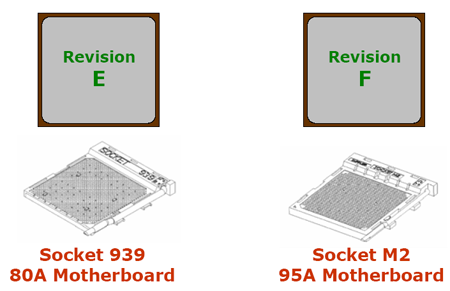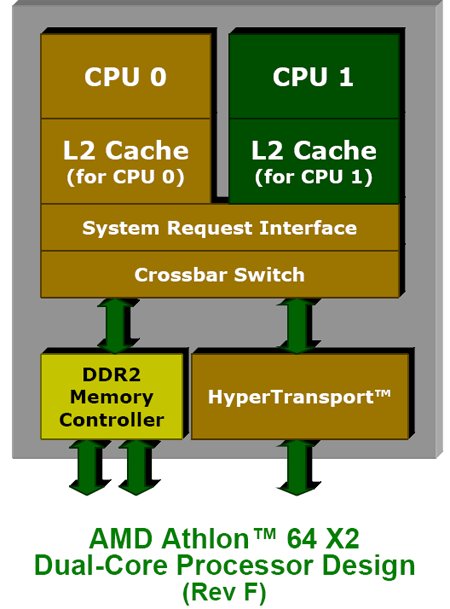Q3'05 AMD Roadmap; DDR2 and New Sockets for AMD
by Kristopher Kubicki & Jarred Walton on July 21, 2005 1:47 PM EST- Posted in
- CPUs
AMD CPU Roadmap Update
We haven't updated our AMD roadmap for a few months, in part due to overlapping NDAs and product launches. Unfortunately we are just about to go under NDA for AMD's next low clock X2 processor - but rather than postpone another roadmap we decided to carry on just without that information. Our last detailed AMD roadmap was actually back in December, and we have quite a bit of new information to cover. We'll focus primarily on the upcoming parts, which will be highlighted in red in our tables, but we'll also list details on many of the currently shipping parts. Let's start with the desktop sector.
Introducing M2
The big news of course is the upcoming transition from socket 939 to socket M2. M2 will have 940 pins, and while the actual layout of motherboards with the new socket will be very similar to socket 939, processors will obviously not be pin compatible. The same goes for current socket 940 processors: they won't work or fit in socket M2. That makes sense, considering that M2 will require the use of DDR2 memory. The similarity in layout will allow motherboard makers to quickly adapt 939 designs to M2, however.
Initially slated to support up to DDR2-667, the socket M2 processors will launch in the second quarter of 2006. Codenamed Orleans for the single core processors, the roadmaps include few details on the clock speeds or cache amounts of the new parts. Without speculating too much, we would assume that the specifications will be the same as equivalent 939 processors, but we could be wrong. Another possibility is that the DDR2 parts will outperform the socket 939 parts, allowing AMD to modify their names (again). Either option seems equally likely, and we wouldn't be surprised to see the 4000+ M2 ship as a 2.6 GHz 512K part, as that would allow the use of a single design for the three listed chips.

Processors running on the new M2 socket are dubbed Revision "F". Revision "F" processors carry all the features of existing "E" CPUs, but along with the new socket comes some significant changes in power. For example, a typical Revision "E" San Diego Athlon 64 utilizes 80 amps with a maximum TDP around 90W. The new Revision "F" CPUs will use 95 amps instead. However, although the processors require a bump in the current, the power remains the same. Unfortunately, expect massive increases in TDP. From the roadmap we expect the FX M2 processors to have a max TDP of 125W, 110W for dual core and 104W for single core. Revision "F" implements a new Bi-Directional PROCHOT so that the motherboard can throttle the processor dynamically, but the CPU can also override and throttle itself if necessary.

The main changes to the processor diagram only appear to be the integrated DDR2 controller instead of the integrated DDR1 controller.










51 Comments
View All Comments
Resh - Friday, July 22, 2005 - link
Not another socket! Geez!ViRGE - Friday, July 22, 2005 - link
Jarred, on the front page, you have two statements that disagree with themselves:---
However, although the processors require a bump in the current, the power remains the same
Unfortunately, expect massive increases in TDP. From the roadmap we expect the FX M2 processors to have a max TDP of 125W...
----
If the "power"(which I interpret as wattage requirement) remains the same, then why is the TDP rising? Do you mean the voltage is staying the same(which with the higher amperage would cause the power drain in wattage to rise)? We have always assumed that TDP was roughly the same as the amount of power the chip draws.
Oh, and AMD needs to come up with less names; my head's doing about 5K RPMs right now with all of this stuff. =P
Doormat - Thursday, July 21, 2005 - link
Nothing about AMD integrating PCI-Express into their CPU? There was an article at TheInq about that...ElJefe - Thursday, July 21, 2005 - link
Er, great!!??DDR2 when its been shown that fast timings and ddr1 at 250mhz vs 200 shows less than 3% difference! yeah! thats what we need???
I remember an anandtech article about a year ago that showed how less bandwidth in trade for severely low timings can actually boost some area's for performance.
m2 = take your money like a mofo'in gangsta
and more heat as a bonus!
im going to be happy when i get my 4400 x2 i think. bah. cant wait again for something that sounds, er worse? maybe it would be better with that virtual crap. whatever that is.
maybe it's like 3d now! when intel was doing great floating point calcs and amd was doing that on my k6-III getting no frames :(
JarredWalton - Thursday, July 21, 2005 - link
6 - You might not even need the BIOS flash. I have no idea, though.5 - I'm a skeptic, I admit. AMD's official launch of 90nm SOI got pushed back quite a bit, IIRC. We're only *just now* hitting the point where AMD is 100% 90nm SOI. The ramp to a new process is almost always slow at first while the kinks get ironed out, and then there's a massive shift at the end. So with that mid-2006 to mid-2007 plot from Hector, I'd be inclined to say 75% of the shift will occur in 2Q'07. (/skeptic)
The main point is that there is no talk in this roadmap of what lies ahead. Could that change in the next month or two? Of course. Sometimes big changes are kept off the roadmaps until 4-6 months prior to the launch, just to keep OEMs and everyone else focused on the current products rather than getting ahead of themselves. Intel isn't talking much about Merom and Conroe either, for example.
NightCrawler - Thursday, July 21, 2005 - link
Athlon 64 4000+ Newark 2.6 GHz 1MB Socket 754 Q3'05Hmmm...I wonder if a bios flash on older 754 boards will allow the use of the newark cpu.
dougSF30 - Thursday, July 21, 2005 - link
A few things:--- "Massive TDP increases" really amount to 20% for the FX, 17% for single core A64s and 0% for DC parts. Significant, okay. Massive? No.
--- Turion & OEMs. 60 design wins and climbing.
--- Pentium M TDP 22W : Well, actually the higher FSB PMs have a 27W TDP. And that doesn't include a memory controller. However, DDR2 is an advantage over DDR. OTOH, no 64b, which per Intel's own admission would bump up the power requirements for them significantly.
--- AMD 65nm timing. Per AMD, production 65nm shipments in H106 (my guess is late Q2). Per Hector in June Technical Analyst Day Q&A, 65nm ramp is from mid-2006 to mid-2007 (100% 65nm). So I think your "late 2006, early 2007" estimate is too far in the future. Should be parts launching in early Q306, having been shipped in late Q206.
--- Socket M2. You fixed the 1207 vs. 940 pin issue.
JarredWalton - Thursday, July 21, 2005 - link
3 - Heh, that's a topic for another day. :) But yeah, there are several new chipsets being worked on by all the major parties for the AMD DDR2 transition.SignalPST - Thursday, July 21, 2005 - link
Is nForce5 arround the corner for these new socket changes?Plifzig - Thursday, July 21, 2005 - link